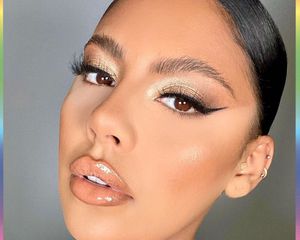
If you have ever found yourself wondering which colors will work best with your skin tone or eye color, you'll want to get familiar with the color wheel. The heart of color theory, the color wheel is a tool frequently utilized to help formulate complementary combinations in everything from painting to outfits—and, yes, makeup.
Ahead, with the help of makeup artist Alex Byrne, we've put together a comprehensive guide on how to use the color wheel to achieve stunning (and effortless) makeup combinations. Keep scrolling for everything you need to know.
Meet the Expert
Alex Byrne is a celebrity makeup artist and men's groomer based in New York City.
What Is the Color Wheel?
The most basic color wheel is composed of 12 colors:
- The three primary colors are red, yellow, and blue
- The three secondary colors are orange, green, and purple
- The six tertiary colors are vermilion (red-orange), magenta (red-purple), violet (blue-purple), teal (blue-green), chartreuse (yellow-green), and amber (yellow-orange)
"The way the color wheel works, colors near each other are 'monochrome,' meaning they are in the same family, and colors opposite are 'complementary,' meaning when placed side by side, they create contrast, and when layered, neutralize each other," explains Byrne. "A real-world example is how holiday colors like red and green make everything look vibrant when placed side by side."
How Can The Color Wheel Influence Our Makeup Choices?
- Creating makeup looks: Not every makeup look needs to utilize color theory, but the color wheel can certainly come in handy. "When you want to create a dynamic look that is more subtle, the color wheel [can help you] create stealth contrast and balanced harmony that makes the finished look truly exceptional," says Byrne. "Once you learn the placement of colors on the wheel, it's easy to make eye color stand out, to pop cheekbones, and to select a lip color that steps up your look."
- Figuring out your undertones: "Most consumers have good instincts for what works for them, but they might not realize that the color wheel impacts their choices, especially when it comes to foundation, concealer, and color cosmetics," says Byrne. These products come in undertones such as warm (golden/yellow) and cool (pink/blue or red/purple). "By trying on foundation shades and seeing which one disappears, we figure out if we need a warm, cool, or neutral undertone to match our skin," she says.
- Color correcting: The color wheel is instrumental in color correction as well. For example, orange is the opposite of blue on the wheel, so if you have dark circles with blue undertones, you can neutralize them with different tones of orange, soft pinks, and peaches before applying your concealer. This extra step can make a significant impact in covering up unwanted blemishes and more.
The Color Wheel and Skin Tones: The Basics
The beauty of humanity is that our skin tones vary and are unique, and there are ways to utilize the color wheel to pick complementary shades of everything from eyeshadows to blushes. "I find that very fair and deep skin tones have the most freedom to wear all colors; they're overall neutral, and I recommend always trying to mix in at least one warm or cool shade to keep the finished look dynamic," says Byrne. "For example, if you have peachy eyeshadow (warm) and a rosey lip stain (warm), try a cool pink cheek color to build quiet contrast."
Conversely, "medium to olive skin tones are generally neutral to warm, so when I want to create a more subtle look, I'll use warm makeup colors that harmonize with the skin," says Byrne. "For extra drama, I'll use cool eyeshadow colors like blues, plums, and purples or cool cheek colors like fuschia to contrast the warm skin tone and really [help the makeup pop]." She recommends MAC's Retro Matte Lipstick in Flat Out Fabulous and Revlon's Matte Lipstick in Pick Me Up.
Choosing The Right Eyeshadow Colors
With literally millions of eyeshadow colors and combinations available, color theory can help you narrow down which color combinations might best complement your eye color. Byrne broke down some of her favorite ways to enhance blue, green, brown, and hazel eyes:
Blue Eyes

"Color pairings are fun because color cosmetics, especially eyeshadows, that contrast the color of the iris instantly make eyes stand out," says Byrne. "On the color wheel, the opposite color to blue is yellow, so a canary eyeshadow does the trick, but any shades with yellow undertones [will] also work magic on blue eyes." Look for anything with gold or ochre tones, like Nars' Eyeshadow in Tulum.
Green Eyes

"For green eyes, the color opposite green is red, and for some, a vivid red or burgundy eye shadow is a favorite," says Byrne. "For a more subtle contrast, some red undertone 'neutrals' include Thrive Causmetics' Waterproof Eyeshadow Stick in Tai, a cranberry matte, and e.l.f's Monochromatic Multi Stick in Luminous Berry. Interestingly, since red is next to pink and violet on the color wheel, they also create brilliant contrast for green eyes."
Brown Eyes

"Brown eyes have a huge range—sometimes with flecks of yellow and even gold in the iris—and are blessed with the ability to wear all colors on the wheel with ease," says Byrne. To make those warm flecks jump out, try cool shades of plum and blue, like those found in Coluorpop's Aurora Struck Palette.
Hazel Eyes

"Usually thought of as a mix between green and blue or green with yellow flecks, hazel eyes light up in orange undertone terracotta shades," says Byrne. "There is a good selection of peachy-orange colors in the Makeup Revolution Forever Flawless Eyeshadow Palette in Good Vibes Spirituality."
The Final Takeaway
From foundation to lipstick, understanding the color wheel can have a lasting impact on how you shop for and apply your makeup. You'll never look at color the same—and that's the most thrilling part of it all.

















